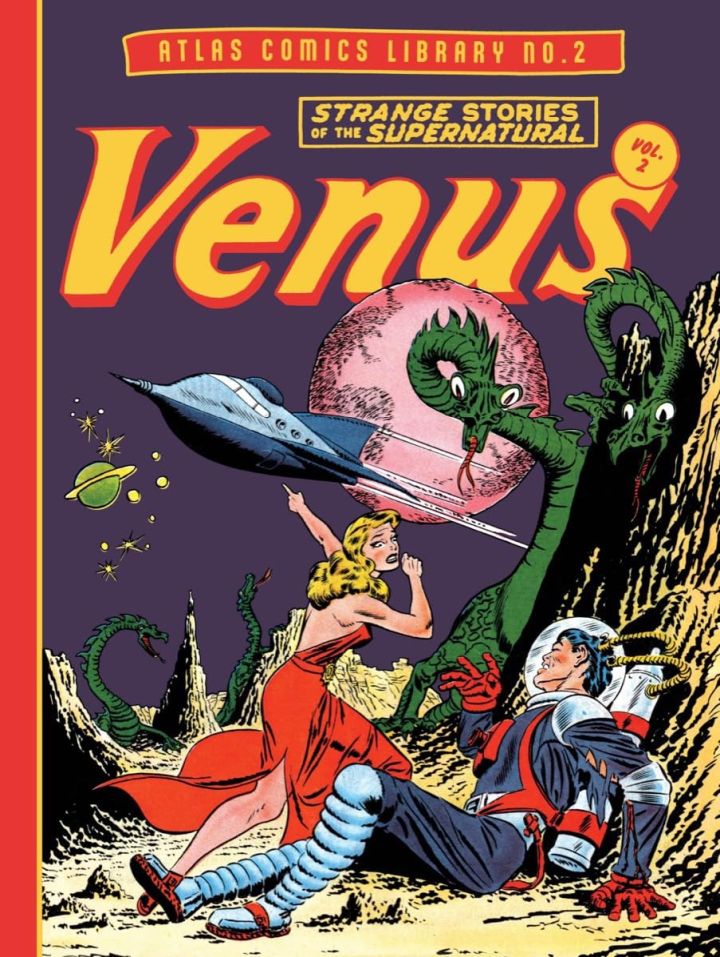
Venus tells a very revealing story – not about its characters or world, but about the world of comic book publishing in the mid-20th century. It tells of how attuned the publishers were to the whims of the public. How quickly they would pivot to try and find just what readers were interested in, just at the moment.
Buy Atlas Comics Library No. 2 Venus Vol. 2 bookVenus began as a “girl comic.” This was in 1948, when superhero comics were on the wane, and other genres were more popular: crime, horror, mysteries, and girl comics. Those starred female heroines and centered around female concerns: romance, essentially, with some light adventure. Venus was published by Timely, which later became Atlas, which later became Marvel.
It’s difficult to describe the basic premise of the comic, because it shifted as the book shifted genres. This collection, Atlas Comics Library No. 2: Venus Vol 2 released by Fantagraphics, is a follow-up to an earlier Marvel Masterworks collection. That book contained Venus 1 – 9, and a couple of ancillary stories. This hardcover contains Venus 10 – 19.
The first volume (which came out in 2011 and is difficult to find in physical form these days) chronicled the tortured origins of the Venus character. She is, in fact, the Roman Goddess Venus, master of love and romance. She wants to experience human love, and so she travels from her home on Venus to Earth. She’s at once spotted by Whit Hammond, the publisher of the ailing Beauty magazine. He hires her as his editor, much to the chagrin of his secretary, Della. She wants the magazine, and Whit, to herself.
These early issues are straight romance, with the central conflict being Della contriving to steal Whit from Venus, and Venus outsmarting her every time. The running theme is that Venus is so stunning that anywhere she goes, she essentially commands every man’s attention.
That lasted three issues. Venus was cancelled briefly in late 1948 but came back in 1949 with more of a supernatural bent. Venus was no longer from Venus, but traveled to Olympus, where Jupiter waited to be cross with her. Cosmologically, it’s a little confused, and gets worse when Loki is introduced (for the first time in Marvel comics, though he has little to do with the Thor villain) despite him being Norse, and Venus Roman. Samson from the Bible and Thor show up eventually, too.
As the comic progresses, things make less sense, and by the time we get to this collection the romance largely takes a back seat to science fiction. Venus is still the apple of every man’s eye, but these men are now flying rockets to the moon or creating machines to make their imagination real, rather than running beauty contests.
By the end of its run, Venus abandons any pretense of romance and becomes a full-fledged horror anthology series, like EC comics, though with a running protagonist.
These latter comics were largely Bill Everett, creator of Namor the Sub-mariner and co-creator of Daredevil. Here, he recreates the previously elevated, regal Venus as a tough-talking New York dame who just happened to have run-ins with the bizarre and supernatural, two or three times an issue.
Each issue of Venus contains five stories: three Venus stories, a back-up comic which start out in early issues as thrillers and eventually become more horror stories, and a two-page text story. The quality of the stories is variable, as was always the case with these anthology comics. They’re short – rarely more than nine pages and often five, so several of them end with mysteries completely elided over. We’ll never learn how the man made his porcelain dolls dance, but it’s really creepy they’re filled with blood. In one story the villain “manufactures ghosts.” How? Don’t know. But the point is more the creepy premise and visuals rather than strict story logic.
The first collected volume of Venus, the Marvel Masterworks release, had digitally reconstructed coloring. This Fantagraphics production looks more like high-quality photographed photos of the old comic pages. For an archival release like this, I much prefer preserving the old-fashioned comic look. Marvel’s re-colorization was flat, without the halftone dotting that provides so much of the old comic-book color character. These old books were meant to be on cheap newsprint. Pristine colors on high quality white paper have, in my opinion, a deadening effect on the illustrations. So, this Venus collection, while not as clear or bold, looks more vibrant than its predecessor. Which makes a difference as the stories become not about normal people in love with a goddess, and more about bizarre creatures imperiling the populace.
As an artifact of an era in publishing where the people’s taste was moving fast, Venus Vol. 2 is fascinating. In 19 issues, from 1948 to 1952, it goes from being an airy romance comic to a hard-edged horror anthology. Issue 19 sports an all-time great horror cover, with a man’s skeleton bursting out from his skin. It’s barely the same book. As pure entertainment, Venus requires some patience. It’s mid-century comic book storytelling. This is more of an enthusiast’s book than a casual reader’s. But hell, the price and the lavish production could tell you that. For the interested, this is a beautiful presentation of a very strange time in Marvel’s publishing history. And a fun, very weird book to read.